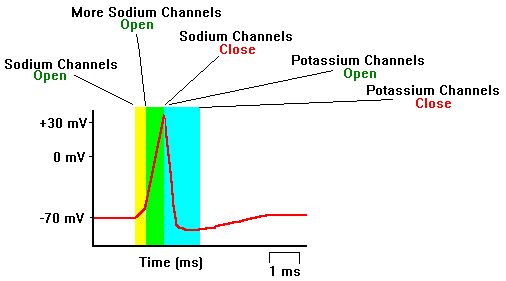Action Potential
 The resting potential tells about what happens when a neuron is at rest. An action potential occurs when a neuron sends information down an axon, away from the cell body. Neuroscientists use other words, such as a "spike" or an "impulse" for the action potential. The action potential is an explosion of electrical activity that is created by a depolarizing current. This means that some event (a stimulus) causes the resting potential to move toward 0 mV. When the depolarization reaches about -55 mV a neuron will fire an action potential. This is the threshold. If the neuron does not reach this critical threshold level, then no action potential will fire. Also, when the threshold level is reached, an action potential of a fixed sized will always fire...for any given neuron, the size of the action potential is always the same. There are no big or small action potentials in one nerve cell - all action potentials are the same size. Therefore, the neuron either does not reach the threshold or a full action potential is fired - this is the "ALL OR NONE" principle.
The resting potential tells about what happens when a neuron is at rest. An action potential occurs when a neuron sends information down an axon, away from the cell body. Neuroscientists use other words, such as a "spike" or an "impulse" for the action potential. The action potential is an explosion of electrical activity that is created by a depolarizing current. This means that some event (a stimulus) causes the resting potential to move toward 0 mV. When the depolarization reaches about -55 mV a neuron will fire an action potential. This is the threshold. If the neuron does not reach this critical threshold level, then no action potential will fire. Also, when the threshold level is reached, an action potential of a fixed sized will always fire...for any given neuron, the size of the action potential is always the same. There are no big or small action potentials in one nerve cell - all action potentials are the same size. Therefore, the neuron either does not reach the threshold or a full action potential is fired - this is the "ALL OR NONE" principle.
